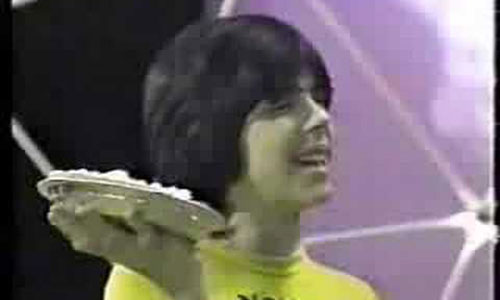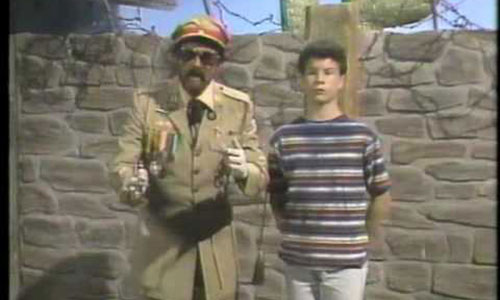You Can't Do That On The Internet
The early Nickelodeon show "You Can't Do That on Television" was built for kids, by kids. Trying to re-create it today would only end in tears.

Wanna be in a TV show?
The intro to the show, which showed children being built in a sausage factory and shipped off in a school bus to a TV studio, running over a production manager in the process, wasn’t actually too far from the truth.
No, there was no sausage factory, unless you consider going to middle school in Ottawa to be a sausage factory. But the idea of kids being hired basically because they came from a local middle school is absolutely true. At least at first.
“There was an announcement over the PA system saying that kids who wanted to try out for a TV show should go to the English class after school,” Christine “Moose” McGlade explained in an interview from earlier this year. “My friend Susan, who was more interested than me, brought me along to be in her skit, and Roger asked me along with five other kids from my school to come to formal, on camera auditions at CJOH (the local TV station). My only prior experience was that I was usually the class clown.”
You may not recognize Moose’s name, but you most certainly recognize her character. McGlade is perhaps the second-best-known performer from the series, with only Alanis Morrissette beating her out due to her appearance in a handful of episodes. Unlike Morrissette, however, you oughta know that McGlade’s fame actually came from the show itself. She spent seven years on various forms of the show, both pre-Nickelodeon and post-Nickelodeon.
(Which, of course, means that she was well into her 20s when she finally left the show in 1986. But she held up the “teen” facade pretty well! Best part: She ended up growing up to become a totally normal digital media exec.)
As the show grew, the approach changed ever so slightly (heck, kids eventually begged to be on the show!) but it never totally got rid of this basic feel.
The old man and the slime
McGlade was far from the only lifer on the show—when kids outgrew the cast, they joined the production staff.
And in the end, the show’s glue wasn’t a kid, but an adult. Les Lye, the show’s only trained comic actor during its early years, took on most of the adult roles, only being joined by a female equivalent, Abby Hagyard, in 1982. Most of the time, these were the only adults on the screen.
Lye’s presence allowed the rest of the cast to play the “straight man.” Generally, shows built on absurdity, like Arrested Development, have one person playing the straight man while the rest of the cast is ramping up the absurdity. YCDTOTV did the opposite, and it still worked.
Lye’s characters are probably what people remember the most from the show. He played a scary burger joint owner who routinely fed his customers rancid meat or animals that probably shouldn’t be eaten; he played a corrupt politician; and he played a military officer, leading a firing squad that was about to kill the kids.
If any of these characters existed in real life, they’d probably be arrested for their actions. But Lye, surrounded by kids four decades younger than he was, somehow made you forget that. And that’s a testament to his talent.
109
The number of total cast members the show had over the years, according to YCDOTOTV.com, a fan site that’s been online for two decades. Helpfully, the site breaks down the exact number of times each cast member has been pied, slimed, and watered. Adam Reid, another lead cast member, managed to get slimed seven times. (That’s it?)

How the Canadian kids took on social issues
There’s this weird episode of Saved By the Bell from 1990 in which Elizabeth Berkeley, overly focused on trying to be as successful as she can possibly be, develops a dependency on caffeine pills.
“I’m so excited, I’m so excited, I’m so … scared!” Berkeley’s character, Jessie Spano, blurts out during a particularly emotional moment.
To this day, it’s the most vividly remembered moment of the entire series, simply because caffeine pills don’t work like that. (It’s possible, but not unless you have a couple dozen caffeine pills at a time.) Clearly “caffeine” was a substitute for cocaine, or other drugs that NBC’s top brass would never allow a children’s show to discuss.
You Can’t Do That On Television had that problem with its 1981 “Drugs” episode as well, but its solution to the issue was a lot more clever: They simply replaced drugs with cream pies.
The goal was to highlight how absurd drug usage is by highlighting the kids’ addiction to cream pies. The result was bizarre and worth watching: There’s nothing more absurd than watching a group of people who can barely act pretending to get high off of getting hit with a cream pie.
If you haven’t seen it, you should. It’s a good introduction to what the show was about, for outsiders, though it admittedly hasn’t aged well.
Grantland′s Rembert Browne, who writes a series about ’80s culture that came before his time, seemed shocked at how low-rent this particular episode was.
“They are still going with the pie schtick. I get it. Please, I beg of you, sweater girl, move on from the pies,” Browne wrote in 2012.
He gave up less than ten minutes in.
“We were at a table reading with the kids, and we needed a name for the show. It was actually called The Unnamed Children’s Project up until then. We were throwing around ideas, and someone mentioned George Carlin’s bit about some of the words you can’t say on television. We started playing from that idea. And from that came the title You Can’t Do That on Television. That’s where it came from.”
— Geoffrey Darby, the co-creator of You Can’t Do That on Television, discussing the origin of the show’s name and concept with Splitsider. Darby was in his early 20s when he first started working on the show. His co-creator, Roger Price, was roughly twice his age, and the creative duo worked closely with the kids who helped drive the action on screen. Darby stayed with Nickelodeon for years afterwards, helping to develop some of its most popular shows, like Double Dare. Despite coming up with the idea of sliming, he never got slimed himself. “I knew better than to get slimed,” he said.

They managed to do it on television. But why did it work?
Despite the low budget, the goofy premise, and the lack of well-known actors, the show had a number of things going for it—the most important of which was timing. The show came about in an era just before cable went mainstream, at a time when local television networks were still producing their own TV shows.
And the show didn’t have educational content, but that was OK—because, as we’ve covered previously, pressure to require such content didn’t come about until later.
The result was that it was able to emerge creatively unscathed by boardrooms, massive budgets, or second-guessing. The show’s creators came up with their best ideas—like green slime—on the fly. Eventually, those ideas became part of the show’s iconic fabric.
Probably the best comparison point to the show’s eventual pickup on the budding cable channel Nickelodeon is Mystery Science Theater 3000, another show berthed from a local TV channel that used its low budget as a creative virtue.
If something like YCDTOTV were created today, it would be on the Web, and there’s a chance that the sheer number of alternative viewing options might have suffocated it. If it were on TV, it’d be a lot lamer, because the educational requirements would have required more adults to get involved.
And you can’t do a show like this if the kids aren’t helping to run the asylum.
The show with the lengthy name and the unlikely reign of success predates the creativity of the internet, but in many ways it implies the kind of wild-child success that so little of our modern television shows do. Saturday morning cartoons are dead; Nicktoons and live-action Disney shows are softened down to the point where the wild abandon is often lost in focus groups and concerns about parent freak-outs. (Ren and Stimpy creator John Kricfalusi provides a textbook example; he pushed the edge one too many times and got fired by Nickelodeon—the first sign that Nick’s second decade wouldn’t be as edgy as its first.)
A good explanation for this phenomenon comes from NPR’s 2009 obit of Les Lye, which noted that the show was largely created by kids, for kids—something that hasn’t really happened on TV since.
“Saved By the Bell was what adults thought kids thought about adults; You Can’t Do That was what kids actually DID think about them,” author Marc Hirsch explained.
Too much of modern kid’s TV is like Saved By the Bell—clearly designed by adults for kids. It’s a successful, but empty, format. So now, the place where kids go to experience the offbeat parts of life is the internet. Tumblr and Instagram and Snapchat and Yik Yak are what early-stage Nickelodeon once was: a place that hasn’t become so closed off and homogenized as to become totally boring.
At least things haven’t gotten boring yet.
:format(jpeg)/2018/04/u0ymy9ptzczgexvtoipo--1-.gif)
/2018/04/u0ymy9ptzczgexvtoipo--1-.gif)

/uploads/ernie_crop.jpg)